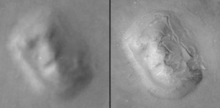pareidolia
English


Etymology
From Ancient Greek παρα (para, “alongside, concurrent”) + εἴδωλον (eídōlon, “image”).
Pronunciation
- Lua error in Module:parameters at line 376: Parameter 1 should be a valid language or etymology language code; the value "RP" is not valid. See WT:LOL and WT:LOL/E. IPA(key): /pæɹ.aɪˈdəʊ.li.ə/
- Lua error in Module:parameters at line 376: Parameter 1 should be a valid language or etymology language code; the value "GA" is not valid. See WT:LOL and WT:LOL/E. IPA(key): /pɛɹ.aɪˈdoʊ.li.ə/
Audio (GA): (file) - Rhymes: -əʊliə
- Hyphenation: par‧ei‧do‧lia
Noun
pareidolia (countable and uncountable, plural pareidolias)
- The tendency to interpret a vague stimulus as something known to the observer, such as interpreting marks on Mars as canals, seeing shapes in clouds, or hearing hidden messages in music.
- Hypernym: apophenia
- 1868 July, John Sibbald, The British Journal of Psychiatry, volume 13, page 238:
- This last is called by Dr. Kahlbaum, changing hallucination, partial hallucination, perception of secondary images, or pareidolia.
- 1993, Raymond Moody, Paul Perry, Reunions: Visionary Encounters with Departed Loved Ones, New York, N.Y.: Random House, →ISBN, page 13:
- Pareidolia underlies several forms of divination.
- 2006, Steve W. Martin, “Choosing Your Battles”, in Heavy Hitter Selling: How Successful Salespeople Use Language and Intuition to Persuade Customers to Buy, Hoboken, N.J.: John Wiley & Sons, →ISBN, page 150:
- Pareidolias aren't solely limited to images. When I was a youngster, I remember listening to The Beatles' song "Strawberry Fields" over and over to hear what seemed to be "I buried Paul."
- 2010, Rick Emmer, “Nessies of the New World”, in Loch Ness Monster: Fact or Fiction? (Creature Scene Investigation), New York, N.Y.: Chelsea House Publishers, Infobase Publishing, →ISBN, page 81:
- Pareidolia is a state of mind where a vague or unclear image is perceived to be something recognizable, regardless of whether it's something you expect to see. The most famous example of pareidolia is the familiar face of the Man in the Moon.
Derived terms
Translations
tendency to interpret vague stimuli as something familiar
|
Further reading
 pareidolia on Wikipedia.Wikipedia
pareidolia on Wikipedia.Wikipedia - Paul McFedries (2004 March 2) “pareidolia”, in Word Spy, Logophilia Limited, retrieved 4 June 2017.
- “pareidolia” in The Skeptic’s Dictionary
Italian
Etymology
From Ancient Greek παρα (para) + εἴδωλον (eídōlon).
Noun
pareidolia f (plural pareidolie)
Derived terms
Polish
Etymology
From Ancient Greek παρα (para, “alongside, concurrent”) + εἴδωλον (eídōlon, “image”).
Pronunciation
Noun
pareidolia f
- pareidolia (tendency to interpret vague stimuli as something familiar)
Declension
Declension of pareidolia
| singular | plural | |
|---|---|---|
| nominative | pareidolia | — |
| genitive | pareidolii | — |
| dative | pareidolii | — |
| accusative | pareidolię | — |
| instrumental | pareidolią | — |
| locative | pareidolii | — |
| vocative | pareidolio | — |
Further reading
Portuguese
Noun
pareidolia f (plural pareidolias)
- pareidolia (tendency to interpret vague stimuli as something familiar)
Categories:
- English terms derived from Ancient Greek
- English 5-syllable words
- English terms with IPA pronunciation
- English terms with audio pronunciation
- Rhymes:English/əʊliə
- English lemmas
- English nouns
- English uncountable nouns
- English countable nouns
- English terms with quotations
- en:Psychology
- en:Senses
- Italian terms derived from Ancient Greek
- Italian lemmas
- Italian nouns
- Italian countable nouns
- Italian feminine nouns
- Polish terms derived from Ancient Greek
- Polish lemmas
- Polish nouns
- Polish entries with topic categories using raw markup
- Polish feminine nouns
- Polish singularia tantum
- pl:Psychology
- Portuguese lemmas
- Portuguese nouns
- Portuguese countable nouns
- Portuguese feminine nouns
